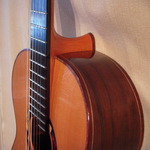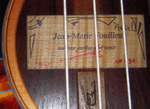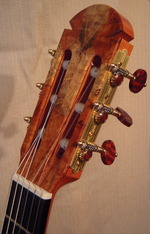Jean-Marie FOUILLEUL
Brittany, France, 2011, No.451
Cedar Soundboard, Rosewood Back and Sides
Raised Ebony fingerboard with 650 mm string length
Mint condition
SOLD (archive)
A lovely instrument from the talented hands of the master luthier working in the Brittany countryside near Mont Saint Michel. The headstock and rosette of this exquisite cedar model are adorned with birdseye Padouk and Malaysian Rosewood. The tone is sweet and singing, with bright accents. An excellent concert guitar with full balanced resonance and power. Jean-Marie's guitars are played by artists in France, Belgium, Germany, Japan and America.
On the excellent DVD tribute to Aaron Shearer "A Life with the Guitar" (Mel Bay) you can hear Ben Beirs playing on a beautiful Fouilleul in a masterclass with Manuel Barrueco.
Here is an interview with Jean- Marie from the magazine "Guitare Classique":
Jean-Marie Fouilleul thought at one time of moving out of France, but in the end this guitar maker chose to set up his workshop in his native Brittany and take advantage of a country environment that affords a certain ease and freedom to his work and his life. Involved in the debate that continues to animate his profession, he is motivated by a desire "to go always further."
Guitare Classique: You originally come from the Rennes area. After having traveled in Normandy and in the Var, here you are again in Brittany. Is it a return to your sources?
I set up my workshop in Rennes in 1984, five years after starting to build guitars in 1979. My meeting with Bruno Perrin was decisive. We planned to go to Italy to study at the Cremona School but we were prevented by certain difficulties. We then set up an association in the south of France, the Var, which gave us a chance to develop our craft from 1980 to 1983. Gilles Mercier joined us for one year. I like the energy of Rennes where I have a lot of contacts with musicians. For the past four years I've been here in the countryside nearby. When you concentrate on building like me (very little repairing) you can work away from centers of business. No problems of commuting, traffic jams! I enjoy a large freedom in my work and I love the countryside.
Tell us more about your collaboration with Bruno Perrin and Gilles Mercier.
As I was telling you, we created a set-up that allowed us to build medium to high quality guitars. Gilles was more advanced than us. It was in that workshop that I started my training. There was a real exchange between us which was very interesting. I took part in the luthier salons in Frankfurt, Germany. From very early on, my guitars were sold through the Guitarreria, the shop run by Isabelle Gomez for the past 20 years. Her excellent advice was a big help in developing my models. That is another kind of collaboration. In 1989 I won the Best Craftsman of France award. The two highest models that I produce today are based on that original design.
You have always been attracted to wood...
Since I was 12 years old I have spent most of my free time at a workbench working on wood. That's just the way it is. I've got a degree in science. I studied physical chemistry for one year at the university, but I've always been passionate about woodworking. When the opportunity to work at this craft appeared I was ready. My father was an organist and I've lived with music ever since my childhood. I played guitar, traditional music. I played at different stringed instruments.
The luthiers with whom we've spoken all have different ideals of tone even though there are some fundamentals they have in common. What is your personal direction?
I've noticed that my fellow luthiers often concentrate on the projection, the volume. I seek rather the largest possible dynamic range. I'm interested in the precision and speed of the attack. I want the guitar to respond to the musician's manner of playing in order to be true to all of his or her nuances, from piano to forte, in short, all dynamic contrasts. I also seek a larger tonal palette. The difficulty is to keep the instrument resonant.
There is always the risk of making the sound a little dry. That involves a very careful selection of woods, keeping in mind their density, their mechanical and acoustical characteristics. I favor spruce as a tone wood. It suits me well because of my work on the bracing and the thicknesses of the wood. Sometimes I make guitars with cedar tops but that is an exception. I attach a lot of importance to the dynamics and the tone palette. I like to listen to the traditional music of Asia, India, North Africa, etc. I'm attracted by the sonorities of the different instruments, they're a source of inspiration for me as a builder. To listen to the Japanese shamisen (a very dry and percussive tone) for example, is a means of developing my ear. Just to have a concept of sonorities demands a great openness to listening.
You have customers in Japan...
I'm always agreeably surprised to see how demanding amateur Japanese guitarists can be. My customers include both conservatory students and serious (and not so serious) amateurs. As my guitars are sold through La Guitarreria in Paris and in shops in Belgium and Switzerland, I don't necessarily know the people who buy them. Sometimes they telephone me and we talk about instruments. I sell as much by directly from my workshop as I do through the stores. One of the pleasures of selling directly from the workshop is meeting the guitarist. We can discuss together the possible personal preferences for the instrument. For example, it's a small matter for me to alter the shape or the size of the neck for the same price.
Your guitars come in two models.
Yes, I have two concert models, the LS1 and the GC. Those names aren't very poetic but after all...(laughs) One is more expensive than the other. I keep a technical record for each instrument in which I note the woods used, the measurements, etc. Thus I can follow the evolution of the models. We luthiers must know how to reproduce a model once its design is established. That's why I like to understand fully all the steps of the construction. I record as many of the elements as possible, wood characteristics, sides...thus I maintain a certain regularity of construction.
What is the waiting period for one of your guitars?
Usually between four and six months, sometimes more, never less. However, customers in Japan prefer to buy from a shop. There they have guitars to compare. It's very hard to sell directly to a musician. And the distance between France and Japan doesn't help. In Europe, on the other hand, it's easier. Often the guitarist prefers to come to the workshop. A relationship develops. I make about 15 guitars a year.
I'd like to talk about the continuing instrument evolution in France...
By nature I'm self-critical, so I'm always reworking the knowledge I've acquired. With a group of luthiers (of violins, of string instrument bows, of Baroque instruments, etc.) we carry on a thought process together about our craft. We get the expertise of acoustic scientists, of wood specialists, of musicians who give their artistic points of view. The goal is to understand, to always go further, to discover. For example, bow makers are facing a real problem with the disappearance of Pernambuco wood which is used for bows. In a few years it will be completely gone. There will be left only the present stock which will also become used up. Thus another wood with equivalent qualities must be found. We must ask ourselves the question, what is the nature of different woods: define their acoustic, physical and dynamic qualities, etc. We carry on this fascinating work under the auspices of the National Union of Instrument Makers which in turn collaborates with the government's bureau of innovative technologies. That way the musical instrument crafts benefit from the latest technological developments.
Interviewed by Josianne Rabemananjara





